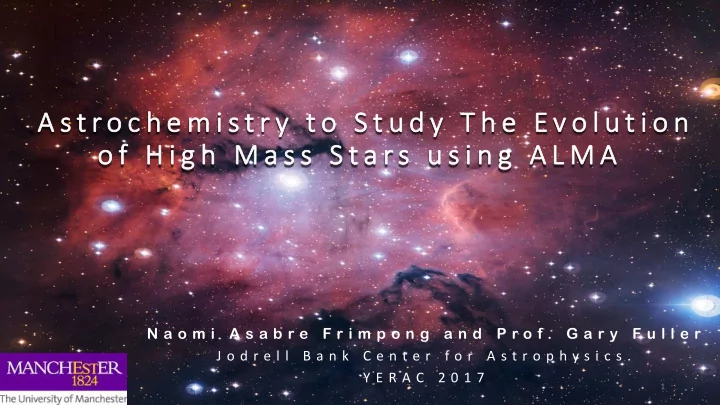

A s A s t r t r o c h e m i e m i s t r t r y y t o S t u t u d y y T h e e E v o l u t i t i o n o f H i g o f i g h M a s s a s s S t a r a r s s u s i n s i n g A L M A N a o m i A s a b r e F r i m p o n g a n d P r o f . G a r y F u l l e r J o d r e l l B a n k C e n t e r f o r A s t r o p h y s i c s . Y E R A C 2 0 1 7 1
In Intr troduc ductio tion • The birth of stars begins in the core of dense molecular clouds under varies physical and chemical conditions. • The collapse and condensation of these dense core of molecular clouds contribute to the formation of proto-stars. • Initiated by turbulence, pressure waves from supernovae, stellar winds and the effect of radiation and magnetic field • High mass stars are 80> mass of the sun. More distant ( ∼ > 400pc) • The formation time of the star is shorter. • Starts nuclear fusion in core before reaching main sequence structure. • high luminosity from nuclear burning and short lifetime • Evans, N. J., 1999, Annual Review of Astronomy and Astrophysics, 37 2
Co Comp mplex mo molecules • Complex molecules are molecules containing 6 or more atoms such as CH 3 OH, CH 3 CN, CH 3 CH 2 CN, CH 3 CCH AND CH 3 CHO. • The interaction of gas with the dust grains in the molecular cloud and the ionization by cosmic rays leads to the formation of complex molecules . • Accretion → Diffusion → Reaction → Cosmic ray/UV interaction → Ejection • The rotation and vibrational spectra given off by the excitation of the molecules give an indication about the physical conditions of the gas, dust and ice mantles. • The chemistry of complex molecules and their spectra can be used as probes to investigate the physical and chemical conditions of gas and dust in their immediate environment. 3
The ALMA Survey Thirty nine (39) massive young stellar objects(MYSO). The • data was taken by ALMA in cycle 3 and in Band 6 covering a frequency range around 227GHz in the (LSB) and 241GHz (USB). ALMA has sufficient resolution and sensitivity to investigate • the various chemical evolutionary tracers of MYSO. The spectral setup covers multiple transitions of a range of • organic species including CH 3 OH,CH 3 CN, CH 3 CCH CH 3 OCH 3 as well as J=2-1 transition of C 17 O and 2-1 transition of CN. ANALYSIS The CASSIS software uses the LTE and Non-LTE radiative transfer model to constrain the physical and chemical properties of the source of interest. Column density • • Kinetic and excitation temperatures Abundance • • Velocities Line width • http://www.dailymail.co.uk/sciencetech/article-2292598/ALMA-Scientists-reveal-stunning-setting-worlds-largest-telescope.html http://cassis.irap.omp.eu/ 4
So Source examp mple - MS MSX6C 6C G025. 025.3953+ 3953+00. 00.0336 0336 MSX6C G025.3953+00.0336 (18h 37m 30.308s - • 6d 41m 18.313s, J2000) is located at 4.0 kpc. It has been identified as a Massive Young Stellar • Object(YSO) in the Red MSX Source(RMS) Survey which contains a H 2 Omaser from the MSX Survey Lumsden et al 2013 5
Li Line Analysis CH3OH SPECIES COMPONENT 1 COMPONENT2 T ex (K) N(cm -2 ) FWHM T ex (K) N(cm -2 ) FWHM 10 15 (km/s) 10 14 (km/s) CH 3 OH 196 10.0 8.1 132 72.0 2.9 200 0.12 9.8 126.7 0.68 3.1 CH 3 CN CH3CN 157.9 1.6 5.1 112.6 4.2 2.5 CH 3 CCH CH3CCH 6
The modelled spectra of the detected species was superimposed on the spectra from the source with an offset of 2K 7
• G017.6380+00.1566 (18:22:26.38s, -13:30:12.00s) is located 2.2kpc . • It has been identified as a Massive Young Stellar Object(YSO) in the Red MSX Source(RMS) Survey which contains a H 2 O maser from the MSX Survey. HN HNCO 8
CH CH3OH 3OH 9
SPECIES COMPONENT 1 COMPONENT2 T ex (K) N(cm -2 ) 10 15 FWHM T ex (K) N(cm -2 ) 10 14 FWHM (km/s) (km/s) CH 3 OH 256 50.6 4.2 120 4.7 3.9 HNCO 204 0.6 6.6 72 0.5 5.6 10
FUTURE These observations will help to address • How the properties of the circumstellar molecular gas changes with source luminosity and SED properties, identifying possible evolutionary trends. • How the mass of dust in the circumstellar region evolves across the range of luminosity and colour. THANK YOU 11
Recommend
More recommend